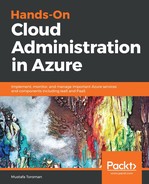In April 2014, Microsoft announced a new approach to Azure with a new portal and ARM model. We already discussed how ARM and RBAC changed the administration of Azure resources and made life in the cloud much easier.
But another option ARM brought to the table was ARM templates. ARM templates are files in JSON format that contain information on all resources in a single resource group. We can use ARM templates to deploy new resources, update resources, or remove resources from a resource group. Every resource group in Azure portal has an automation blade that allows us to save an ARM template for that resource group, redeploy resources, or download a template locally. This allows us to replicate resources from a resource group quickly and simply.
This is why placing resources for a single application is common practice in Azure. If we have a complicated environment that takes some time to deploy, it can be very useful. For example, let's say that we have a SharePoint farm with Windows Server running a domain controller role, two servers for SharePoint farm, and two additional servers running SQL Server. This requires us to create a virtual network, create five servers, and add them to the virtual network. Doing this manually in the Azure portal requires some time to create. But with ARM templates we can do this in a matter of seconds.
Deploying infrastructure with ARM templates is only one option for infrastructure as a code. We can achieve similar things with PowerShell and Azure CLI as well. Using infrastructure as a code allows us to deploy infrastructure needed to run our application in a fast and reliable way. It's a more consistent option as well because we are excluding manual tasks from deployment, creating an automated process, and eliminating human error in deployment.
Another great thing about ARM templates is that they can be added to our application project and stored in a repository, and we can keep track of versions of our environment. Different versions of an application may require changes in environment and with ARM templates and code repositories we can keep track of these changes and make sure that the correct environment is deployed for the version of the application we are deploying.
To sum everything up, ARM templates are a fast, reliable, and consistent way to deploy Azure resources that allow us to keep track of environment versioning and automate deployment processes. This is especially interesting and useful if we are trying to implement DevOps in our software delivery. In combination with configuration as a code (we'll talk about this in later chapters), we can build or replicate any environment with all resources required and apply the configuration needed for everything to run correctly.
A sample of an empty ARM template is shown here:
{
"$schema": "https://schema.management.azure.com/schemas/2015-01-01/deploymentTemplate.json#",
"contentVersion": "1.0.0.0",
"parameters": {
},
"variables": {
},
"resources": [
],
"outputs": {
}
}
An ARM template contains information on parameters, variables, resources, and outputs. Using this information we define what resources need to be deployed, using which parameters, and which of these parameters can be variables that can be changed. Finally, we define the output as a replay, but this part is optional.
